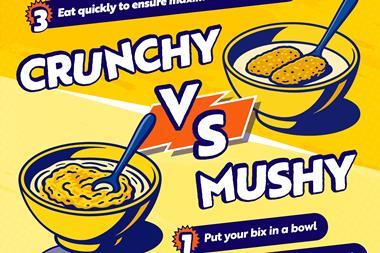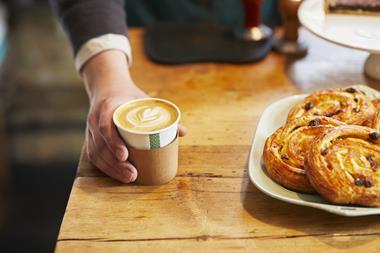Meal deal options can be an effective way of boosting sales, writes Aidan Fortune. Just follow a few simple rules and you can’t go wrong
Food to go is an established footfall driver and offers high margins, but you could be getting even more out of it by providing meal deals in your store. Selling a selection of products at a discounted price can not only generate more sales, but help out your time-strapped customers.
Kepak convenience business unit controller Angela Daulby says that retailers need to be offering meal deals to satisfy consumer demand for fast food on the go. “HIM CTP research discovered that 79% of purchases in convenience stores are consumed immediately or within two hours, highlighting a big opportunity for retailers to tap into the food-to-go market through meal deals,” says Daulby. “Meal deals are now very familiar to consumers as they appear more frequently on the high street. They offer value for money which is very important for today’s consumer and help make the lunchtime decision simpler for shoppers.”
Retailer’s view
“We offer bacon sandwiches and hot drinks as part of a meal deal. It’s very popular in the morning and lunchtime, especially with builders who work in the area. We used to offer a jacket potato as part of the deal, but that didn’t sell as well so we stopped that. It’s important to know which deals work and which don’t, and modify your range accordingly.”
Tessa Randell, Londis Southwater,West Sussex
Nisa retailer Kishor Patel says that meal deals provide another reason for customers to visit your store. “As well as generating more footfall for the store, offering meal deals keeps you at the forefront of consumers’ minds,” he says. “If they know they can get a quick meal deal option at your store, they will keep coming back.”
Oxxygen Marketing Partnership’s Max Jenvey explains that for meal deals to work properly retailers need to offer up plenty of choice. “More flexibility in the products retailers offer in a meal deal will increase interest and consumer desire,” he says. “If the consumer is confined to a small number of choices, the less likely they are to like those products. If there is more flexibility, the more likely the retailer is to attract different interests of the various customers, therefore selling more meal deals.”
Although he says that the traditional meal deal option of a sandwich, packet of crisps and soft drink is still the most popular with customers, Kishor is trying to vary his offering. “There is definitely room to push the price up to £4 and offer a share size soft drink or crisps,” he says. “I’m also considering offering a scratchcard or magazine as part of a meal deal. It’s still early days for these options but you need to think outside the box to attract customers.”
Daulby makes another point: “Retailers need to ensure that offers are well communicated, and siting the products together is essential.”
At their simplest level meal deals need only comprise prepackaged components such as a pasty, bag of crisps and can of Coke, points out Country Choice marketing controller Stephen Clifford. “However, these lack the appeal of a freshly made product a handmade filled baguette or breakfast bap with a coffee is a far more attractive alternative,” he says.
Clifford also recommends soup as a low-cost option for retailers as part of a meal deal offer. “Soup is a very popular lunchtime choice for consumers, although it is very seasonal, from September through March,” he says. “Providing soup as a food-to-go item is very simple operationally a soup kettle and three or four varieties of chilled soup rotated daily are all that’s needed.”
He adds that merchandising can also be kept to the basics. “Meal deals can be created by simply using shelf-talkers to link products, such as having a poster by the coffee machine telling people that coffee is half-price with a baguette, and the same on the sandwich fixture.”
Top tips
*Advertise. Hand out promotional leaflets to inform customers about meal deals.
*Concentrate on merchandising. Place posters of meal deals inside and outside your store to encourage impulse purchases
*Make a splash. Create meals deals around special dates such as Valentine’s Day and Mother’s Day
*Taste testing. Introduce customers to new meal deals and gauge their success at the same time by offering free taste tests *Give the meal deals a name it helps creates an identity. You can also use pictures or logo to appeal to customers.
Meal deals aren’t just confined to breakfast and lunch, either. There is an avenue for retailers to increase the number of purchasing occasions by offering deals suitable for evening meals. “There is definitely an opportunity for evening meal deals,” asserts Max Jenvey. “Consumers are often pressed for time, not least because of irregular and long working hours, which means fewer people have time for lunch. These pressures can also intrude on evening meal preparation and eating.”
Clifford says that for evening deals, retailers need to consider fast food options that also include alcohol products.
“Breakfast and lunch deals tend to revolve around coffee or a soft drink with a main product,” says Clifford. “However, in the evenings there has been success with pizza and wine, or curries and beer.”
Kishor says that he will be trialling evening meals in his stores in the coming weeks. “We’re hoping to offer a curry with a four-pack of beer and dessert and depending how it performs it may become a permanent offering,” he says.
Daulby adds that retailers shouldn’t worry too much about waste if they decide to offer evening meals. “By installing a microwave retailers can offer hot meal deals throughout the day, without the concerns over waste and additional labour costs associated with food-to-go counters,” she says. “Hot snacking products, such as Rustlers and UGO’s Deli Café, have longer shelf lives than sandwiches, resulting in less waste.”
While waste may not be an issue, price can be a concern for retailers testing the water with meal deals. With the big supermarkets getting in on the act, independents may feel that the multiples can undercut them when it comes to meal deal prices. However, convenience stores still have the edge thanks to their flexibility of opening hours, according to Jenvey. “Convenience is an overriding consideration in choosing a c-store, whether it’s because it is nearby, which ranks first in importance with consumers (HIM Food to Go Study 2010) or because of its longer opening hours (ranks third),” he says. “Price does rank second in importance, indicating that c-stores cannot allow their prices to drift too far away from the supermarket levels. They don’t have to be lower prices, but they can’t be too much higher.”
Unfazed by the multiples, Kishor says that consumers are willing to pay more for premium offerings. “We charge about £3 for a deal and I think this is a fair price,” he says. “The price lets customers know that they are quality products. In fact, if a meal deal is too cheap consumers won’t buy it as they will think that it products aren’t a good quality.”
Clifford agrees that convenience stores shouldn’t fear the multiples. “There is always pressure on prices from the major supermarkets, but a recent survey by IGD among food-to-go buyers showed price to be sixth on their list of priorities,” he says. “Food-to-go buyers first and foremost look for quality and freshness, followed by convenience and service. If you offer choice, quality and a friendly service, people will pay.”





























No comments yet